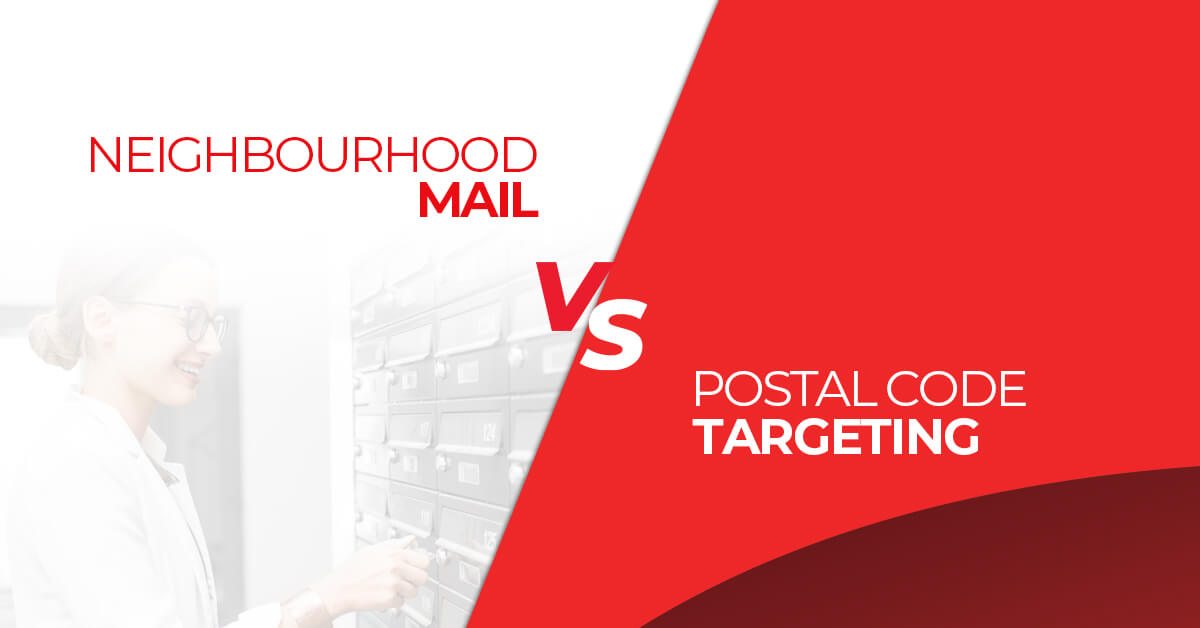
Want to create a direct mail campaign that converts but not sure which type is best for your business? Two of the most common types of direct mail include neighbourhood mail and postal code targeting. But what’s the difference between neighbourhood mail vs. postal code targeting?
Our direct mail specialists will explain the differences between neighbourhood mail vs. postal code targeting. Plus, we’ll examine how to target the neighbours of your best customers with the help of postal code targeting and discuss the advantages that offers. For example, targeting the direct neighbours of your current customers allows you to reach like-minded people. In addition, by targeting neighbours, you can promote positive word of mouth – because we all know neighbours talk about their experiences with products and services!
Before we dive in, here are some features that distinguish neighbourhood mail vs. postal code targeting.
| Feature | Neighbourhood Mail (NM) | Postal Code Targeting (PCT) |
| Postage Rates (2024) | $0.197 per household (+ $0.01 extra for oversized pieces) | $0.435 per household (including data costs) |
| Ease of Use | Easiest | Difficult |
| Formats | Letters in Envelopes, Postcards, Folded Postcards, Catalogs, etc. | Letters in Envelopes, Postcards, Invitations, etc. |
| Minimum Order Size | 100, or, 1 “Walk”; 500 if you DIY |
150 |
| Target Cluster Size | 1x “Letter Carrier Walk” – 300 – 600+ homes |
1x Postal Code – 15 – 25+ homes |
| Tracking | Yes** | Yes** |
| Addressed | No | Yes |
| Delivery Standards | Slowest (5 – 17 days) | Fastest (3 – 5 days) |
*Minimum order size is dependent. See below for more information.
**Tracking capabilities are based on 3rd party tools, including Call Tracking and QR Codes.
This is a complex question because there are many reasons to use each type of direct mail. In fact, if, at some point, you are targeting a lot of postal codes with PCT, you should probably send out NM to save money!
To help make this less cryptic, here are some specific scenarios in which you would want to use Neighbourhood Mail vs. Postal Code Targeting.
Still not sure which type of mail to send out? Our team can help. Call us to discuss your campaign goals, and we’ll help you create the best strategy to achieve them!
First things first – let’s take a look at what a Canadian postal code is and how it works. Why is this important? Well, it will help you better understand the differences in targeting capabilities between neighbourhood mail vs. postal code targeting campaigns. This information will also show just how powerful it is to be able to target a 6-digit postal code.
So, what is a postal code? A Canadian postal code is a 6-digit number that specifies a particular neighbourhood. The first three digits of a postal code are referred to as the FSA (Forward Sortation Area) code. You’ll find more information about 3-digit FSA codes below.
In an urban area, a 6-digit Canadian postal code is a collection of 15 to 25 single-family houses (on average). Apartment buildings (or blocks) often have their own postal code assigned. Thus, in the case of an apartment building, a postal code could have 100s of households in it.
In rural areas, things are a bit different. A rural 6-digit postal code can cover hundreds of square kilometres.
Below is a map of a sample area for a 6-digit rural postal code. In this case, all the households in this area would be included in a Postal Code Targeting (PCT) direct mail campaign.
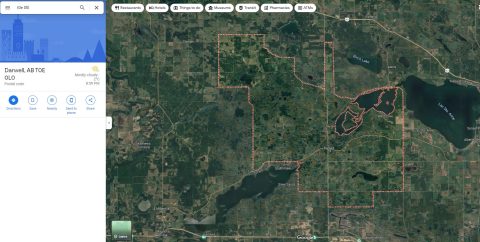
Canadian postal codes are extremely valuable for marketing because, as data shows, like-minded people tend to live in the same area. In other words, people that live in the same postal code have similar lifestyles. In fact, Prizm Data from Environics has been able to gather data and pinpoint 67 unique lifestyle types that define neighbourhoods throughout Canada.
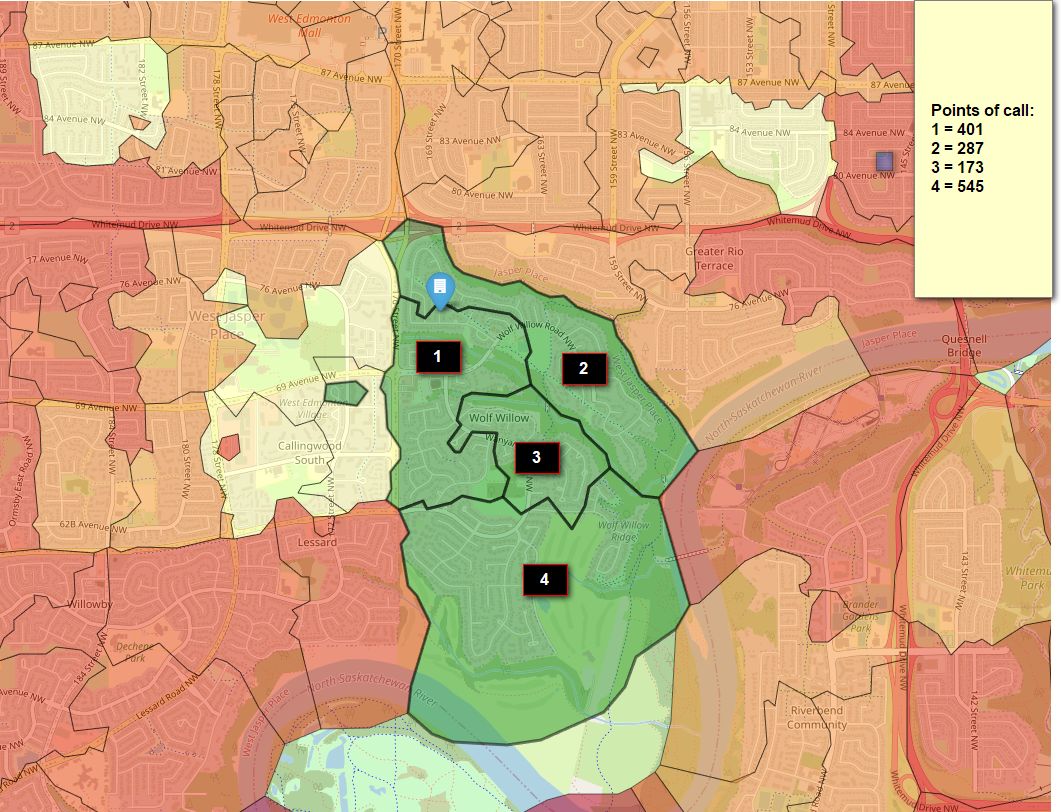
As mentioned above, the first three digits of a Canadian postal code are known as the Forward Sortation Area or FSA. This area contains tens of thousands of households.
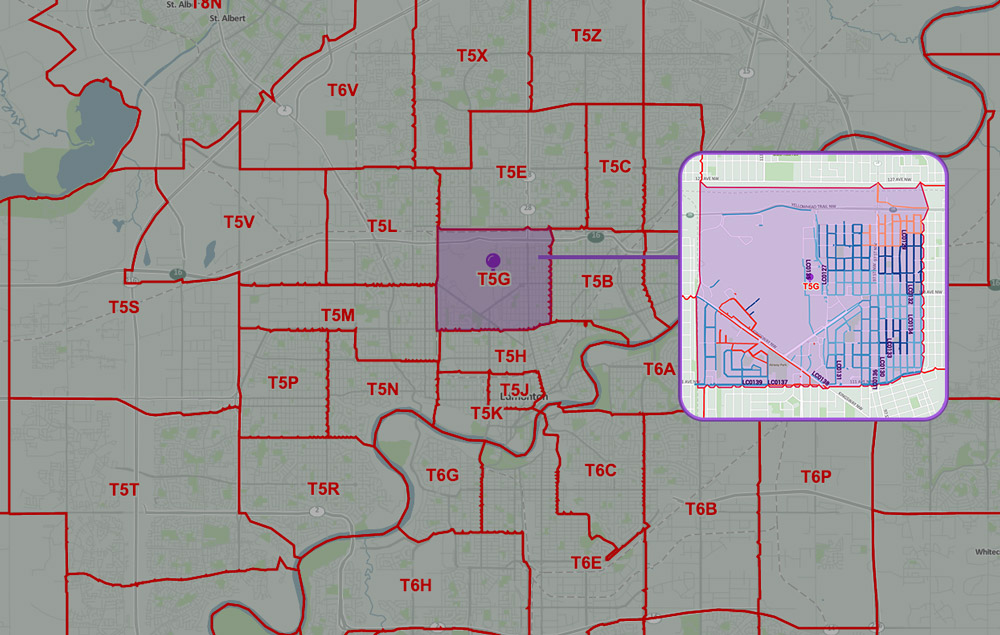
Now, digital marketing lets you target by postal code. However, digital campaigns can only target at the 3-digital level! In other words, digital campaigns only allow marketers to target an area as granular as 10,000+ households. As you can imagine, this capability is vastly inferior to being able to target 15 to 25 homes.
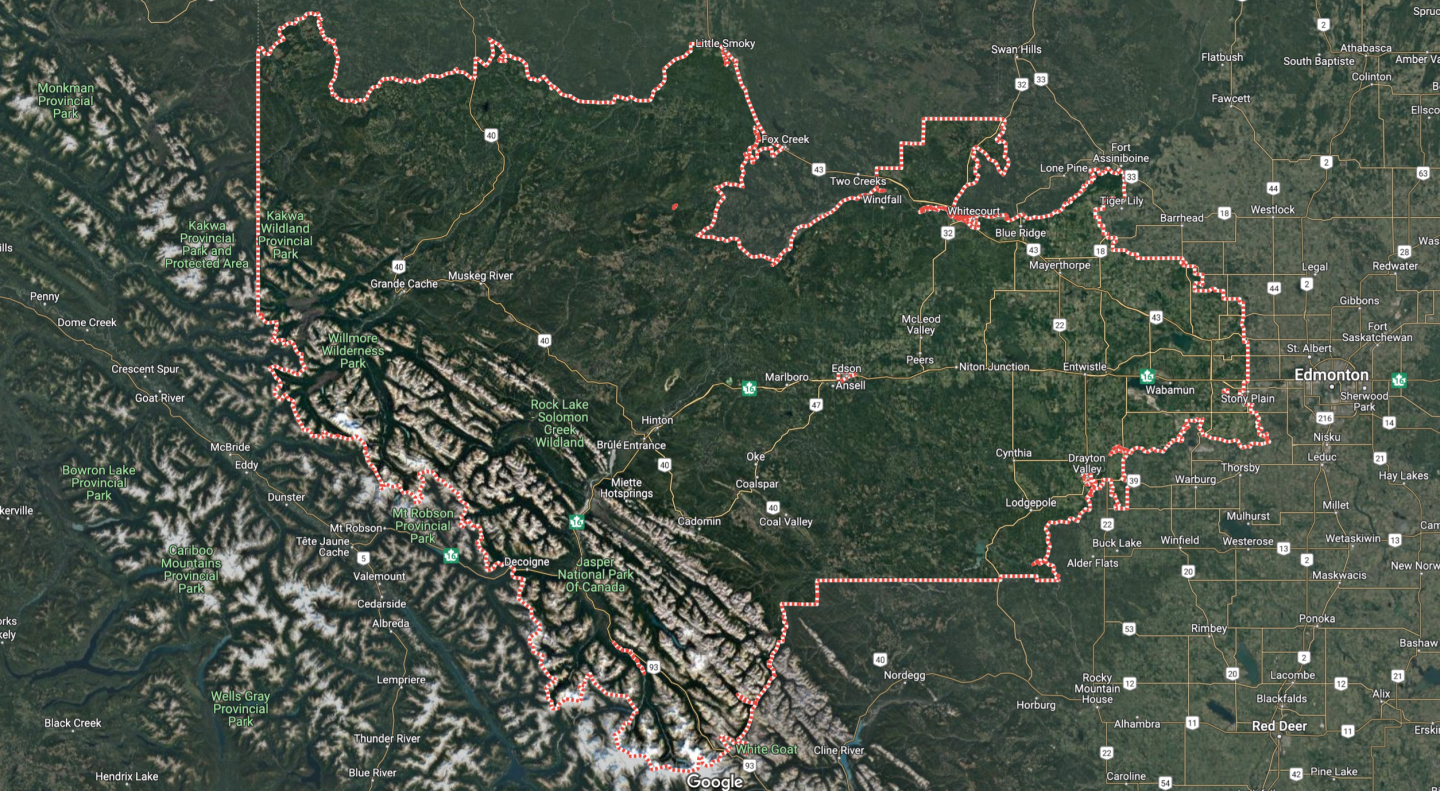
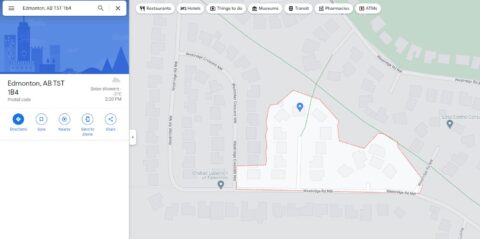
Now, let’s take a closer look at neighbourhood mail vs. postal code targeting campaigns.
Neighbourhood mail, often abbreviated to NM in the direct mail industry, is Unaddressed Mail.
This type of direct mail is ideal for lead generation and fostering brand awareness. In addition, NM is effective for advertising current promotions or events, promoting new products and services, and encouraging customer loyalty and word-of-mouth referrals. For example, new businesses can use neighbourhood mail to promote a grand opening.
Using Neighbourhood Mail, you can target nearly any address in Canada! That’s because this service has protected access to every building. On the other hand, mail services like local mail and newspaper distributors cannot enter certain locations, including apartments with bulk mail rooms.
Sometimes called a “Letter Carrier Route”, this is the delivery area that a Letter Carrier/Canada Post Delivery Employee delivers mail to each day. When sending a Neighbourhood Mail campaign, you can select the Neighbourhood Walks you want your direct mail campaign to be delivered to.
Most Neighbourhood Walks contain 300 to 500 households. However, some high-density, urban areas may contain more homes.
You can deliver your NM campaign to a partial Letter Carrier Route. However, you will not be able to control which of the households receive your mail piece and which do not. In this case, it’s a luck-of-the-draw situation.
Not sure which neighbourhoods your business should be targeting? A Canada Post expert partner like One To One Mailing can help you identify the right neighbourhoods.
With Neighbourhood Mail, you can send postcards, envelopes, etc., as well as oversized items.
A Standard Neighbourhood Mail piece can be up to 12” x 6” x 1” (length x width x thickness) and 500 grams. Oversized Neighbourhood Mail pieces can be even larger, with a maximum size of 12” x 11” x 1” (length x width x thickness) and 500 grams. Oversized neighbourhood mail costs just $0.01 more!
According to the 2024 Canada Post Neighbourhood Mail customer guide, when preparing your own direct mail campaign, the minimum quantity is “1 Neighborhood Walk”. While a typical Neighbourhood Walk is 300 – 500 homes, there are smaller ones across the country with less than 100!
When you work with a Canadian-based mailhouse like One To One Mailing or PostNow, you can send as few as 100 postcards with a Neighbourhood Mail campaign. We know the tricks to get it done.
Using Neighbourhood Mail, you can target a “neighbourhood walk.” In other words, all the homes within the area that a given postal worker delivers to in a single day.
What if you don’t want your mail delivered to every home in a neighbourhood walk? Fortunately, you can target less than a full neighbourhood walk. However, you cannot guarantee which homes in the area will get your mail pieces. Thus, this is not a great option for repeat marketing efforts.
Canada Post’s targeting tool for NM is called Precision Targeter. Using this tool, you can:
The postage rate for a standard piece of neighbourhood mail for 2024 is $0.197 per household, up from the $0.184 rate in 2024. Upgrading this to an oversized mail piece will cost just $0.01 extra.
Companies that send over $10,000 in postage/year are eligible for significant cost savings with Neighbourhood Mail contract rates. If you are looking to establish a contract rate with Canada Post, our team can connect you with the right people! Give us a call today to get started – 1-866-482-2412.
Neighbourhood Mail campaigns have many benefits. The most significant advantages of NM include:
Like anything, in addition to numerous benefits, neighbourhood mail also has some disadvantages. For example:
Now that you have a better idea of what Neighbourhood Mail is and how it works, let’s take a closer look at Postal Code Targeting.
Postal Code Targeting direct mail, abbreviated to PCT, is a type of hybrid mail. Essentially, it is Addressed Mail but without a name. It allows you to take your existing customer data (i.e. customer addresses) and use the postal codes to target the exact neighbours of your current customers!
Postal Code Targeting originated in the UK. PCT arrived in Canada when Canada Post invested in the UK’s technology so that they could manage these types of mail campaigns and data. This type of direct mail is very unique. In fact, only a few countries worldwide have access to such granular targeting. Not even the USA has this capability!
On top of incredibly precise targeting potential, PCT also has the shortest delivery times of any direct mail campaign type. Canada Post’s delivery standards for PCT are 3 – 5 days. However, at PostNow, we have seen Postal Code Targeting campaigns delivered in less than 24hrs from induction (i.e. delivery from Edmonton to Edmonton).

Did you know – PostNow can help you create and deliver a successful Postal Code Targeting direct mail campaign?
Here are some benefits of using PostNow to create a PCT campaign.
The targeting capabilities of neighbourhood mail vs. postal code targeting differ substantially. Using Postal Code Targeting, you can target a much smaller and more specific target market. That’s because PCT allows you to target distinct 6-digit postal codes.
As discussed above, a 6-digit postal code contains approximately 15 to 25 homes or an individual condo or apartment building.
Since condo and apartment buildings have their own unique postal codes, you can cherry-pick the specific residential buildings you want to target. This option is perfect for real estate agents, local businesses, and other industries that value the ability to target precise buildings.
Due to its more granular targeting potential, PCT is often preferred over neighbourhood mail for smaller and more precise campaigns.
The postage rate for a piece of Postal Code Targeting mail is $0.435 per household. Keep in mind that this includes data costs!
When compared to Personalized Mail and the “name and address” data that is available for purchase, this is almost 50% of the cost. As a result, PCT is a smart way to add personalization without incurring significant fees.
Like Neighbourhood Mail, Postal Code Targeting direct mail has numerous advantages. The benefits of PCT include:
Before choosing which type of direct mail is right for your business, consider these disadvantages of Postal Code Targeting.
Do neighbourhood mail and postal code targeting direct mail sound like the same thing? If you think so, you’re not alone – this is a common misconception. In fact, for a long time, people thought of Neighbourhood Mail as Postal Code Targeting because of Canada Post’s Precision Targeter tool and how it works. Digital ad channels also added to the confusion by blurring FSAs with Postal Codes. By doing so, these channels made it difficult for people to understand how small a 6-digit Postal Code target area actually is.
That said, there are some significant differences between Neighbourhood Mail vs. Postal Code Targeting. Two of the biggest differences include cost and the specificity of the target area. Neighbourhood Mail is cheaper than Postal Code Targeting direct mail. However, with PCT, you can be much more specific in who you target. This means better open and response rates!
Check out the chart above to learn more about the similarities and differences between Neighbourhood Mail vs. Postal Code Targeting.
So, now that you know more about these types of direct mail, which should you use for your business? Let’s take a look.
If you want to target your ideal customers and get results, direct mail is a great way to do it! And with the help of PostNow and Canada Post, you can create and deliver the perfect campaign. But how can these organizations help?
You might be wondering – what’s the difference between PostNow and Canada Post? Are they the same thing? The answer is – NO. PostNow is not Canada Post.
If you want to create a direct mail campaign, you cannot work directly with Canada Post to get it completed. Instead, you will need to work with a mail house – like PostNow.
Canada Post has numerous Expert Smartmail Partners across Canada, including PostNow. These mail houses are trusted by Canada Post to help businesses print and design direct mail campaigns.

So then, what role does Canada Post play? Well, Canada Post is essentially the broadcast channel. They do not print, design or help with the targeting for your campaign. Instead, they just take your completed campaign and deliver it to the areas you specify.
Thus, to ensure that you have the experience and expertise necessary to create a mail campaign that converts, you will need to work with a mail house/Canada Post Expert Partner like PostNow.
Ready to start building a successful direct mail campaign? PostNow can help. Call us today to get started!
